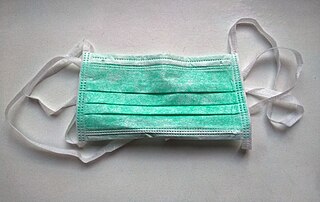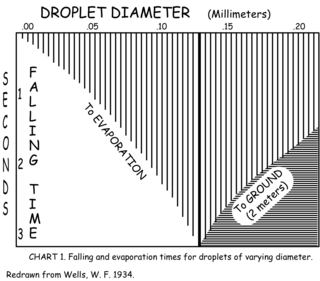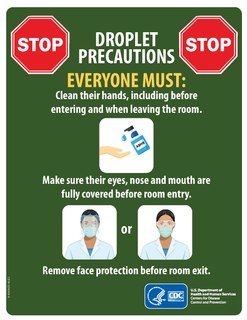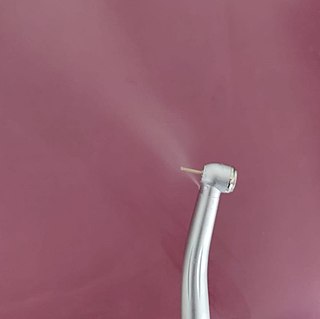
An infection is the invasion of an organism's body tissues by disease-causing agents, their multiplication, and the reaction of host tissues to the infectious agents and the toxins they produce. An infectious disease, also known as a transmissible disease or communicable disease, is an illness resulting from an infection.

An epidemic is the rapid spread of disease to a large number of people in a given population within a short period of time. For example, in meningococcal infections, an attack rate in excess of 15 cases per 100,000 people for two consecutive weeks is considered an epidemic.

The common cold, also known simply as a cold, is a viral infectious disease of the upper respiratory tract that primarily affects the nose. The throat, sinuses, and larynx may also be affected. Signs and symptoms may appear less than two days after exposure to the virus. These may include coughing, sore throat, runny nose, sneezing, headache, and fever. People usually recover in seven to ten days, but some symptoms may last up to three weeks. Occasionally, those with other health problems may develop pneumonia.

In medicine, public health, and biology, transmission is the passing of a pathogen causing communicable disease from an infected host individual or group to a particular individual or group, regardless of whether the other individual was previously infected.

A surgical mask, also known as a face mask, is intended to be worn by health professionals during healthcare procedures. It is designed to prevent infections in patients and treating personnel by catching bacteria shed in liquid droplets and aerosols from the wearer's mouth and nose. They are not designed to protect the wearer from breathing in airborne bacteria or viruses whose particles are smaller. With respect to some infections like influenza they appear as effective as respirators, such as N95 or FFP masks; though the latter provide better protection in laboratory experiments due to their material, shape and tight seal.

In infectious disease ecology and epidemiology, a natural reservoir, also known as a disease reservoir or a reservoir of infection, is the population of organisms or the specific environment in which an infectious pathogen naturally lives and reproduces, or upon which the pathogen primarily depends for its survival. A reservoir is usually a living host of a certain species, such as an animal or a plant, inside of which a pathogen survives, often without causing disease for the reservoir itself. By some definitions a reservoir may also be an environment external to an organism, such as a volume of contaminated air or water.
Bovine alphaherpesvirus 1 (BoHV-1) is a virus of the family Herpesviridae and the subfamily Alphaherpesvirinae, known to cause several diseases worldwide in cattle, including rhinotracheitis, vaginitis, balanoposthitis, abortion, conjunctivitis, and enteritis. BoHV-1 is also a contributing factor in shipping fever, also known as bovine respiratory disease (BRD). It is spread horizontally through sexual contact, artificial insemination, and aerosol transmission and it may also be transmitted vertically across the placenta. BoHV-1 can cause both clinical and subclinical infections, depending on the virulence of the strain. Although these symptoms are mainly non-life-threatening it is an economically important disease as infection may cause a drop in production and affect trade restrictions. Like other herpesviruses, BoHV-1 causes a lifelong latent infection and sporadic shedding of the virus. The sciatic nerve and trigeminal nerve are the sites of latency. A reactivated latent carrier is normally the source of infection in a herd. The clinical signs displayed are dependent on the virulence of the strain. There is a vaccine available which reduces the severity and incidence of disease. Some countries in Europe have successfully eradicated the disease by applying a strict culling policy.
Aerosolization is the process or act of converting some physical substance into the form of particles small and light enough to be carried on the air i.e. into an aerosol. Aerosolization refers to a process of intentionally oxidatively converting and suspending particles or a composition in a moving stream of air for the purpose of delivering the oxidized particles or composition to a particular location.

Bioaerosols are a subcategory of particles released from terrestrial and marine ecosystems into the atmosphere. They consist of both living and non-living components, such as fungi, pollen, bacteria and viruses. Common sources of bioaerosols include soil, water, and sewage.

Mycoplasma gallisepticum (MG) is a bacterium belonging to the class Mollicutes and the family Mycoplasmataceae. It is the causative agent of chronic respiratory disease (CRD) in chickens and infectious sinusitis in turkeys, chickens, game birds, pigeons, and passerine birds of all ages.
Influenza prevention involves taking steps that one can use to decrease their chances of contracting flu viruses, such as the Pandemic H1N1/09 virus, responsible for the 2009 flu pandemic.
Transmission-based precautions are infection-control precautions in health care, in addition to the so called "standard precautions". They are the latest routine infection prevention and control practices applied for patients who are known or suspected to be infected or colonized with infectious agents, including certain epidemiologically important pathogens, which require additional control measures to effectively prevent transmission. Universal precautions are also important to address as far as transmission-based precautions. Universal precautions is the practice of treating all bodily fluids as if it is infected with HIV, HBV, or other blood borne pathogens.

The Wells curve is a diagram, first developed by W. F. Wells in 1934, which describes what happens to respiratory droplets once they have been exhaled into air. Coughing, sneezing, and other violent exhalations produce high numbers of respiratory droplets derived from saliva and/or respiratory mucus, with sizes ranging from about 1 µm to 2 mm. Wells' insight was that such droplets have two distinct fates, depending on their sizes. The interplay of gravity and evaporation means that droplets larger than a humidity-determined threshold size fall to the ground due to gravity, while droplets smaller than this size quickly evaporate, leaving a dry residue that drifts in the air. Since droplets from an infected person will typically contain infectious bacteria or viruses, these processes influence transmission of respiratory diseases.

A respiratory droplet is a small aqueous droplet produced by exhalation, consisting of saliva or mucus and other matter derived from respiratory tract surfaces. Droplet sizes range from <5 µm to 1000 µm. Large droplets fall to the ground or another surface before drying, but smaller ones fall slowly and dry so quickly that they usually become aerosolized particles. Respiratory droplets can be produced naturally as a result of breathing, talking, sneezing, coughing, or vomiting, or can be artificially generated through aerosol-generating medical procedures. Since droplets can contain infectious bacterial cells or virus particles they are important factors in the transmission of respiratory diseases.
A toilet plume is the dispersal of microscopic particles as a result of flushing a toilet. Normal use of a toilet by healthy people is considered unlikely to be a major health risk. There is indirect evidence that specific pathogens such as norovirus or SARS coronavirus could potentially be spread by toilet aerosols, but as of 2015, no direct experimental studies had clearly demonstrated or refuted actual disease transmission from toilet aerosols. It has been hypothesized that dispersal of pathogens may be reduced by closing the toilet lid before flushing, and by using toilets with lower flush energy.

The genus Orthopneumovirus consists of pathogens that target the upper respiratory tract within their specific hosts. Every orthopneumovirus is characterized as host specific, and has a range of diseases involved with respiratory illness. Orthopneumoviruses can cause diseases that range from a less-severe upper-respiratory illness to severe bronchiolitis or pneumonia. Orthopneumoviruses are found among sheep, cows, and most importantly humans. In humans, the orthopneumovirus that specifically impacts infants and small children is known as human respiratory syncytial virus. Pneumoviruses have been traced by researchers from the Center for Disease Control and Prevention and the University Medica Centre in Utrecht, Netherlands on how orthopneumoviruses attack infants and small children.

A dental aerosol is an aerosol that is produced from dental instrument, dental handpieces, three-way syringes and other high-speed instruments. These aerosols are air suspended in the clinical environment. These aerosols can pose risks to the clinician, staff and other patients as well. The heavier particles of the aerosols suspend in the air for relatively short period and settles down quickly, but the lighter particles tend to remain suspended for longer periods and are capable to enter and get deposited in the lungs when they are inhaled and possess the capacity of transmitting diseases.
Lydia Bourouiba is an Esther and Harold E. Edgerton Professor, an Associate Professor in the Civil and Environmental Engineering and Mechanical Engineering departments, and in the Institute for Medical Engineering and Science at the Massachusetts Institute of Technology. She is also a Harvard-MIT Health Sciences and Technology Faculty, and Affiliate Faculty of Harvard Medical School. She directs the Fluid Dynamics of Disease Transmission Laboratory at MIT. Her research considers the fluid dynamics of disease transmission. During the COVID-19 pandemic, Bourouiba studied respiratory pathogen emissions and their implications for coronavirus disease.
Human-to-human transmission (HHT) is a particularly problematic epidemiologic vector, especially in case the disease is borne by individuals known as superspreaders. In these cases, the basic reproduction number of the virus, which is the average number of additional people that a single case will infect without any preventative measures, can be as high as 3.9. Interhuman transmission is a synonym for HHT.
COVID‑19 is a new disease, and many of the details of its transmission are still under investigation. COVID-19 is thought to spread mainly through respiratory droplets produced when an infected person coughs, sneezes, or talks. Social distancing and the wearing of cloth face masks, surgical masks, respirators, or other face coverings are controls for droplet transmission. It may be possible that a person can get COVID-19 through indirect contact by touching a contaminated surface or object, and then touching their own mouth, nose, or possibly their eyes, though this is not thought to be the main way the virus spreads. Kissing, physical intimacy and other forms of direct contact can easily transmit COVID-19.












